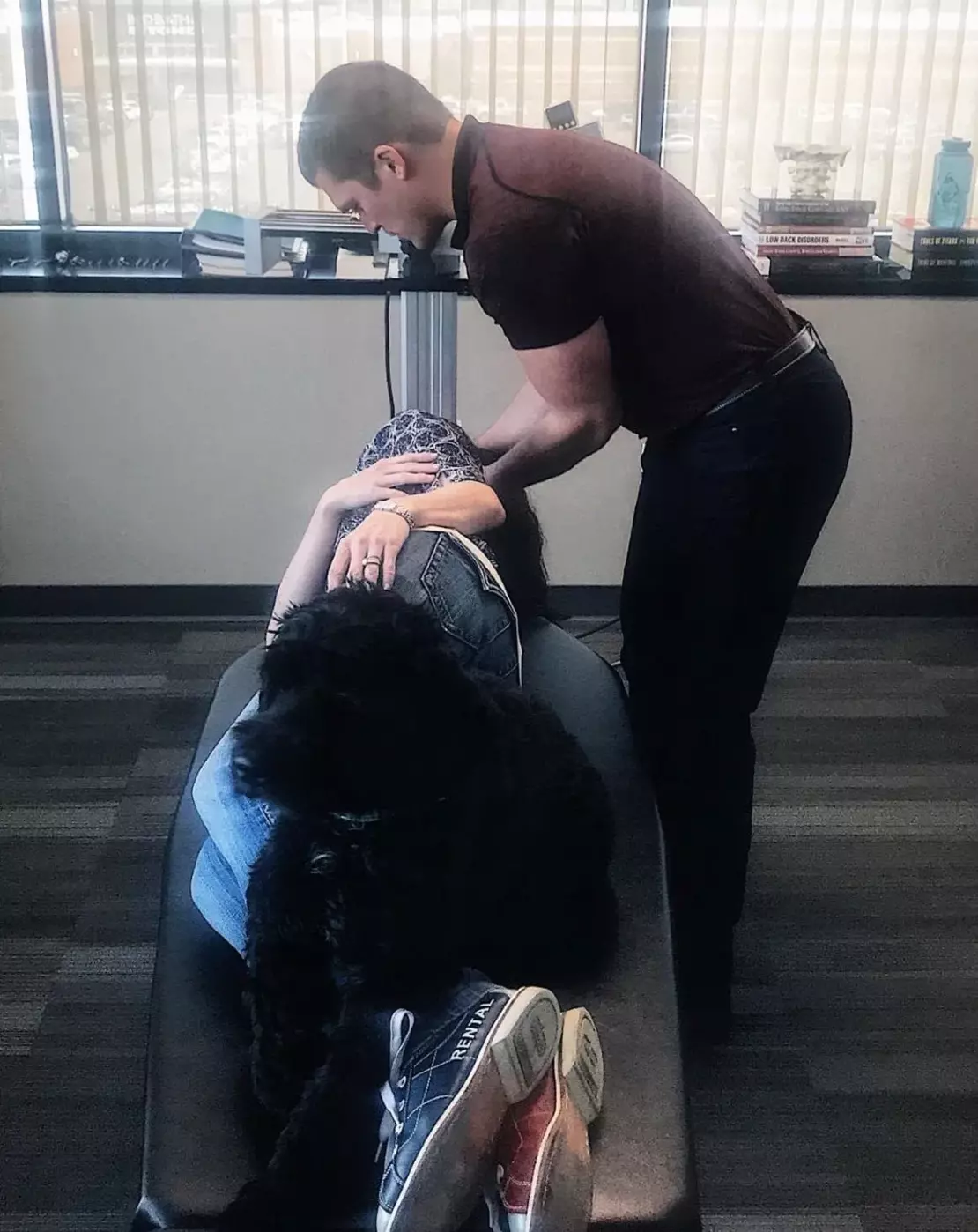- info@denveruppercervical.com
- 303-955-8270
Thoracic Back Pain: Causes & Treatment
Exploring the Unique Causes of Headaches in Denver and How Chiropractic Care Provides Relief
Thoracic back pain is middle back pain due to injury or tension in your thoracic spine. Thoracic back pain can spread to your ribs , neck, or other parts of your back. The most common cause is muscle tension due to poor posture.
What is the best way to manage thoracic pain? The best way to manage thoracic pain is by maintaining good posture. You can also use stretches and exercises to strengthen your core muscles and ease muscle tension.
Below is everything you need to know about thoracic back pain. If you’re looking for science-based holistic chiropractic care, schedule an appointment with Denver Upper Cervical Care today.
What is the Thoracic Spine?
The thoracic spine is the middle section and longest region of your spine. Its main purposes are to protect the spinal cord and other vital organs in the chest, anchor the rib cage, and provide stability.
The thoracic spine’s vertebrae (labeled T1-T12) connect to the cervical spine in the neck (vertebrae labeled C1-C7) and to the lumbar spine in the lower back (vertebrae labeled L1-L5).
Poor posture, obesity, back injury, or other medical conditions can lead to thoracic back pain, also called middle back pain .
Symptoms of Lumbago
Lumbago/lower back pain isn’t a single disease — instead, it is a symptom of many different medical conditions affecting the lower back.
What is a symptom of lumbago ? Symptoms of lumbago include:
- Chronic pain in the lumbar region (lower back)
- Soreness in the back
- Pain or tingling sensation down one or both legs
- Muscle spasm
- Weakness in one or both legs
- Stiffness/muscle tension in the lower back
Depending on the cause of lumbago, other symptoms may also occur. For example, if lumbago is caused by a herniated disc, the pain will increase while sitting but decrease when lying down. Lumbago that is due to scoliosis could also cause an abnormal curvature of the spine.
Risk Factors
The most common risk factors for low back pain include:
- Poor posture
- Older age
- Obesity
- Lack of exercise
- Heavy lifting, especially when it’s part of your occupation
- Smoking
- Kidney or bladder problems
- Pregnancy
Common Causes for Upper & Mid-Back Pain
So what are the most common causes of thoracic back pain? Thoracic back pain is most commonly caused by one or more of the following conditions:
The most common cause of thoracic back pain is muscle irritation or muscle tension due to poor posture.
Many of us sit at work or at home, and most of us do not have good posture. If you spend a lot of your days hunched or slouched over, your muscles can get tense and cause mid-back pain.
Tip: To improveyour posture, practice good posture for short periods and work your way up to longer stretches of time. For example, instead of looking down at your phone, try holding it up and looking at it straight-on for a few minutes.
There are multiple ways your spine can get injured, whether by a single traumatic event or over time.
- Car accidents — Automobile collisions are a very common source of injured spine. Sudden crashes can damage every portion of your spine, including your thoracic spine.
- Sports injuries — Athletic injuries are another common way to injure your thoracic spine — especially in contact sports.
- Overuse injuries — Repeated twisting, lifting, or bending motions can lead to overuse injuries of the thoracic spine.
- Disc herniation — The spinal discs between the vertebrae can become herniated, which puts pressure on the spinal nerves, causing pain or numbness. Herniated disc is more common in males and those aged 30-50 are at higher risk.
- Disc degeneration — Degenerative disc disorders cause inflammation, resulting in severe back pain.
- Vertebral damage — Injury to the vertebrae (spinal bones) can cause pain, putting pressure on the spinal cord or the spinal nerves.
- Osteoporosis and osteoarthritis — These bone conditions increase your risk of damage or vertebral compression fractures.
- Other conditions — In some cases, thoracic back pain can be caused by various medical conditions, such as ankylosing spondylitis orScheuermann’s disease (a type of structural kyphosis).


Ovesity is a risk factor for thoracic back pain. While not always the direct cause of back pain, it can lead to other conditions that cause back pain.
Chronic pain conditions, like fibromyalgia and lupus, may lead to back pain. Pain associated with these conditions isn’t confined to the spinal region — pain is typically experienced all over the body.
This might cause thoracic back pain. The curvature can be minor or severe, as can the pain associated with the curvature. There are 3 types of spine curvature to look out for:
- Scoliosis — an abnormal curve to one side.
- Kyphosis — excess outward curve. This looks like hunching forward.
- Lordosis — excess inward curve. Usually in the lower back, this is commonly referred to as a “swayback” posture.
Thoracic back pain may occur when spinal nerves become irritated, injured, or inflamed. Although uncommon, some nerve conditions include:
- Thoracic radiculopathy — pinched nerves
- Post-herpetic neuralgia — a nerve condition related to shingles
- Spinal stenosis — occurs when the space inside the vertebra is too narrow and compresses the nerve
Thoracic spinal joints may go through cartilage tears or degeneration. This facet joint dysfunction often leads to thoracic back pain.
Pregnant women often experience thoracic and low back pain because of the weight of the growing fetus and the natural loosening of their ligaments. This can result in sore ribs and middle back discomfort.
Most chiropractors are trained to treat women during pregnancy.

Treatment Options for Thoracic Spine Pain
What are some treatments for thoracic back pain? The most effective treatment options for thoracic spine pain include the following:
- Chiropractic care — Chiropractic adjustments reposition the spine to alleviate pinched nerves, headaches , nervous system issues, thoracic back pain, and other health concerns. Chiropractic can improve range of motion and provide spinal pain relief.
- Physical therapy — Physical therapy can be an effective treatment option to stretch and strengthen the back muscles to improve flexibility and balance, as well as decrease pain. Physical therapists may recommend at-home exercises and stretches to maintain muscular health.
- Massage — Because muscle tension is a leading cause of thoracic back pain, massaging muscles and relieving tension can alleviate pain.
- Posture therapy — Physical therapists, chiropractors , and other experts can help you learn how to sit, stand, and go about your day with good posture. This posture education should help treat thoracic back pain.
- Cold and heat — Cold or heat therapy can help with thoracic back pain, depending on the root cause. Inflammation or swelling should be alleviated by applying ice, and tight muscles or soreness should be treated by safely applying heat.
- Trigger point injections — Healthcare providers can administer trigger point injections for muscle spasm and tension in the mid and upper back. Trigger point injections usually include a local anesthetic and a steroid medication.
- Medication — Many conventional doctors prescribe muscle relaxants or pain meds to treat thoracic back pain. Unfortunately, medication only masks symptoms instead of addressing the underlying cause. Medications like anti-inflammatories do help reduce the pain, which may make physical therapy or chiropractic adjustments more comfortable.
- Surgery — Kyphoplasty and vertebroplasty are both minimally-invasive surgeries which involve injecting a special bone cement into compressed vertebrae, easing nerve pain and strengthening thoracic spine.
Can exercise help with thoracic back pain? Certain exercises can help with thoracic back pain, such as core strengthening exercises and
Prevention
The best treatment for thoracic back pain is prevention. Treatment after the fact can get expensive and feel like an uphill battle. Prevention is cheaper and much more comfortable.
Check out these effective ways to prevent thoracic back pain before it begins:
- Practice sitting with good posture. Sit up straight no matter where you are. This should help prevent back pain and neck pain.
- Take frequent breaks at work or at home if you’re sitting or standing in the same position for a long period of time — to avoid muscle tension.
- Seek out preventative chiropractic care.
- Get regular massages to avoid chronic muscle tension.
- Use your legs to lift, not your back. This is a good tip for lower back pain, too.
- Avoid sudden motions that could lead to muscle strains or sprains.
- Exercise to strengthen the muscles in your core in order to protect your spine.
- Learn stretches which relieve muscle tension and alleviate pressure in the thoracic region.
- Sleep on your side or on your back , putting less pressure on your spine.
How do I stretch my thoracic spine? The best ways to stretch your thoracic spine include cat and cow stretch, open book stretch, intercostal stretch, and downward dog.
When to Get Help
Because the thoracic region is so close to vital organs, thoracic pain may indicate a serious condition for which you should seek medical attention right away.
You don’t always need to go to the ER for thoracic back pain. Here are the red flags to look out for:
- Thoracic back pain that doesn’t get better after 2-4 weeks of treatment or good posture
- Change in the shape of your spine, such as lumps or bumps
- Chest pain accompanied by heart attack symptoms like crushing pain in your limbs
- Severe stiffness every morning
- Severe pins and needles that never go away
- Chronic weakness in your legs
- Major numbness that persists for days
When should I worry about thoracic back pain? You should worry about thoracic back pain when the discomfort, soreness, or stiffness doesn’t get better with treatment after 2-4 weeks.
Chiropractic Can Help
Looking for individualized medical advice and conservative treatment options that apply to your unique situation? Schedule an appointment with us today!
Sources:
- Korabelnikova, E. A., Danilov, A. B., Danilov, A. B., Vorobyeva, Y. D., Latysheva, N. V., & Artemenko, A. R. (2020). Sleep disorders and headache: A review of correlation and mutual influence. Pain and therapy , 9 (2), 411-425. Full text: https://www.ncbi.nlm.nih.gov/pmc/articles/PMC7648824/
- Elizagaray-Garcia, I., Beltran-Alacreu, H., Angulo-Díaz, S., Garrigos-Pedron, M., & Gil-Martinez, A. (2020). Chronic primary headache subjects have greater forward head posture than asymptomatic and episodic primary headache sufferers: Systematic review and meta-analysis. Pain medicine , 21 (10), 2465-2480. Full text: https://www.researchgate.net/profile/Ignacio-Elizagaray-Garcia-2/publication/345144818_Chronic_Primary_Headache_Subjects_Have_Greater_Forward_Head_Posture_than_Asymptomatic_and_Episodic_Primary_Headache_Sufferers_Systematic_Review_and_Meta-analysis/links/61c44cd7c99c4b37eb1878af/Chronic-Primary-Headache-Subjects-Have-Greater-Forward-Head-Posture-than-Asymptomatic-and-Episodic-Primary-Headache-Sufferers-Systematic-Review-and-Meta-analysis.pdf
- Fischer, M. A., & Jan, A. (2019). Medication-overuse headache. Full text: https://www.ncbi.nlm.nih.gov/books/NBK538150/
- Jovel, C. E., & Mejía, F. S. (2017). Caffeine and headache: specific remarks. Neurología (English Edition) , 32 (6), 394-398. Full text: https://www.sciencedirect.com/science/article/pii/S2173580817300858
- Leung, A. (2020). Addressing chronic persistent headaches after MTBI as a neuropathic pain state. The Journal of Headache and Pain , 21 (1), 77. Full text: https://www.ncbi.nlm.nih.gov/pmc/articles/PMC7304149/
- Kaur, A., & Singh, A. (2013). Clinical study of headache in relation to sinusitis and its management. Journal of Medicine and Life , 6 (4), 389. Full text: https://www.ncbi.nlm.nih.gov/pmc/articles/PMC3973877/
- Kikkeri, N. S., & Nagalli, S. (2022). Migraine with aura. In StatPearls [Internet]. StatPearls Publishing. Full text: https://www.ncbi.nlm.nih.gov/books/NBK554611/
- Ruschel, M. A. P., & De Jesus, O. (2023). Migraine headache. In StatPearls [Internet]. StatPearls Publishing. Full text: https://www.ncbi.nlm.nih.gov/books/NBK560787/
- Al Khalili, Y., & Chopra, P. (2020). Hypnic Headache. Full text: https://www.ncbi.nlm.nih.gov/books/NBK557598/
- Arca, K. N., & Halker Singh, R. B. (2019). The hypertensive headache: a review. Current pain and headache reports , 23 , 1-8. Full text: https://www.iranheadache.ir/wp-content/uploads/2020/04/The-Hypertensive-Headache-a-Review.pdf
- Jersey, A. M., & Foster, D. M. (2018). Cerebral aneurysm. Full text: https://www.ncbi.nlm.nih.gov/books/NBK507902/
- Vernon, H., Borody, C., Harris, G., Muir, B., Goldin, J., & Dinulos, M. (2015). A randomized pragmatic clinical trial of chiropractic care for headaches with and without a self-acupressure pillow. Journal of manipulative and physiological therapeutics , 38 (9), 637-643. Abstract: https://pubmed.ncbi.nlm.nih.gov/26548737/
- Al Khalili, Y., Ly, N., & Murphy, P. B. (2018). Cervicogenic headache. Full text: https://www.ncbi.nlm.nih.gov/books/NBK507862/
- Urits, I., Patel, M., Putz, M. E., Monteferrante, N. R., Nguyen, D., An, D., … & Viswanath, O. (2020). Acupuncture and its role in the treatment of migraine headaches. Neurology and therapy , 9 , 375-394. Full text: https://www.ncbi.nlm.nih.gov/pmc/articles/PMC7606388/
- Jimenez, M. P., DeVille, N. V., Elliott, E. G., Schiff, J. E., Wilt, G. E., Hart, J. E., & James, P. (2021). Associations between nature exposure and health: a review of the evidence. International Journal of Environmental Research and Public Health , 18 (9), 4790. Full text: https://www.ncbi.nlm.nih.gov/pmc/articles/PMC8125471/
The post Thoracic Back Pain: Causes & Treatment appeared first on Denver Upper Cervical Chiropractic.
© 2025 Denver Upper Cervical Chiropractic

